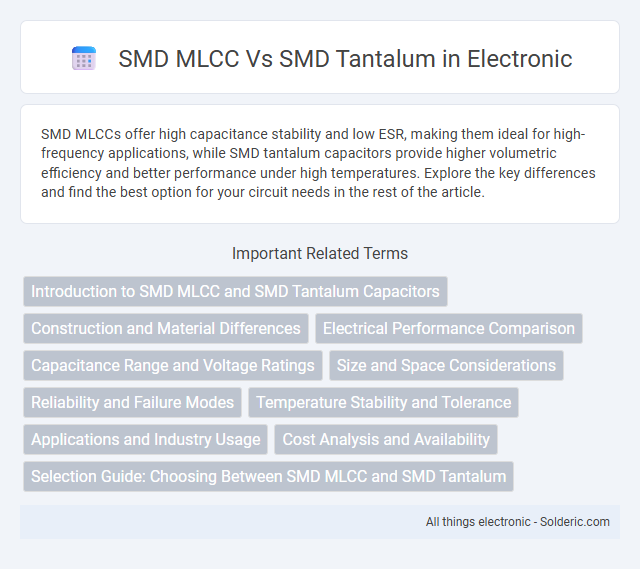SMD MLCCs offer high capacitance stability and low ESR, making them ideal for high-frequency applications, while SMD tantalum capacitors provide higher volumetric efficiency and better performance under high temperatures. Explore the key differences and find the best option for your circuit needs in the rest of the article.
Comparison Table
| Feature | SMD MLCC | SMD Tantalum |
|---|---|---|
| Capacitance Range | 0.1 pF to 100 uF | 0.1 uF to 470 uF |
| Voltage Rating | 4 V to 500 V | 2 V to 50 V |
| ESR (Equivalent Series Resistance) | Low ESR | Moderate to Low ESR |
| Capacitance Stability | High stability over temperature and voltage | Moderate stability, degrades at high temperature |
| Size | Smaller, thinner profiles | Generally larger than MLCCs |
| Failure Mode | Open circuit | Short circuit (can be catastrophic) |
| Applications | High-frequency filtering, decoupling | Bulk capacitance, power supply filtering |
| Cost | Lower cost per unit | Higher cost per unit |
Introduction to SMD MLCC and SMD Tantalum Capacitors
SMD MLCC (Surface-Mount Device Multilayer Ceramic Capacitors) feature multiple ceramic dielectric layers, providing high capacitance in a compact size ideal for high-frequency applications and excellent temperature stability. SMD Tantalum capacitors utilize tantalum metal anodes, offering high capacitance per volume and superior volumetric efficiency, making them suitable for low-voltage, high-reliability circuits where stable electrical performance and long lifespan are critical. Understanding the fundamental differences between SMD MLCC and SMD Tantalum capacitors enables you to select the optimal component for your electronic design requirements.
Construction and Material Differences
SMD MLCC (Multilayer Ceramic Capacitors) consist of multiple layers of ceramic dielectric material sandwiched between metal electrodes, providing high capacitance in a small, stable footprint. SMD Tantalum capacitors use a tantalum metal anode with a solid manganese dioxide or polymer electrolyte, offering higher capacitance per volume but with different voltage and stability characteristics. Your choice depends on the required capacitance density, ESR (Equivalent Series Resistance), and temperature stability unique to these construction and material differences.
Electrical Performance Comparison
SMD MLCCs (Multilayer Ceramic Capacitors) exhibit low equivalent series resistance (ESR) and excellent high-frequency performance, making them ideal for decoupling and filtering applications. In contrast, SMD tantalum capacitors offer higher capacitance per volume and stable capacitance over a wide temperature range but generally have higher ESR and lower frequency response. Your choice between these capacitors should consider the specific electrical characteristics required for your circuit, such as capacitance stability, ESR, and frequency performance.
Capacitance Range and Voltage Ratings
SMD MLCC capacitors typically offer capacitance ranges from a few picofarads up to several microfarads, with voltage ratings commonly between 6.3V and 100V, making them suitable for high-frequency applications. In contrast, SMD tantalum capacitors provide higher capacitance values, often from 1uF to hundreds of microfarads, and voltage ratings generally ranging from 4V to 50V, ideal for stable, bulk energy storage. Choosing between these depends on your circuit's required capacitance and voltage thresholds, ensuring optimal performance and reliability.
Size and Space Considerations
SMD MLCCs offer significantly smaller sizes and higher volumetric efficiency compared to SMD tantalum capacitors, making them ideal for space-constrained applications. MLCCs can achieve high capacitance values in compact 0402 and 0603 package sizes, while SMD tantalum capacitors generally occupy larger footprints due to their construction. Designers prefer MLCCs when optimizing PCB real estate and minimizing overall device dimensions.
Reliability and Failure Modes
SMD MLCCs (Multi-Layer Ceramic Capacitors) offer high reliability due to their robust ceramic dielectric, exhibiting low failure rates in high-frequency applications but can suffer from microcracking under mechanical stress. SMD tantalum capacitors provide stable capacitance and excellent performance in low-voltage circuits but are more prone to catastrophic failure from surge currents and voltage spikes. Understanding these failure modes helps optimize Your circuit design for longevity and performance by selecting the appropriate capacitor type based on operating conditions.
Temperature Stability and Tolerance
SMD MLCCs (Multilayer Ceramic Capacitors) offer superior temperature stability with a wide operating temperature range typically from -55degC to 125degC and tight capacitance tolerance often within +-10%, making them ideal for precision applications. In contrast, SMD tantalum capacitors may have more limited temperature stability, generally operating from -55degC to 85degC, and exhibit wider tolerance levels such as +-20%, which can affect performance in high-temperature environments. Your choice between these capacitors should consider the application's temperature demands and tolerance requirements to ensure reliable circuit function.
Applications and Industry Usage
SMD MLCCs (Surface-Mount Device Multi-Layer Ceramic Capacitors) are widely used in high-frequency circuits, consumer electronics, automotive systems, and telecommunications due to their excellent stability and low ESR (Equivalent Series Resistance). SMD tantalum capacitors excel in applications requiring high capacitance values, compact size, and reliable performance under steady DC voltage, commonly found in power management, medical devices, and aerospace industries. Your choice between SMD MLCC and tantalum capacitors depends on the specific electrical requirements and environmental conditions of the application.
Cost Analysis and Availability
SMD MLCCs generally offer lower costs and higher availability due to widespread manufacturing and use in diverse applications, making them a cost-effective choice for volume production. SMD tantalum capacitors are typically more expensive because of their specialized materials and limited suppliers, leading to constrained availability and longer lead times. Cost efficiency and procurement flexibility often favor MLCCs, especially for designs requiring large quantities.
Selection Guide: Choosing Between SMD MLCC and SMD Tantalum
When selecting between SMD MLCC (Surface-Mount Device Multilayer Ceramic Capacitors) and SMD tantalum capacitors, consider key factors such as capacitance range, voltage rating, and ESR (Equivalent Series Resistance). MLCCs are preferred for high frequency applications due to their low ESR and ESL, while tantalum capacitors excel in providing stable capacitance and higher volumetric efficiency at lower frequencies. Application environment, reliability requirements, and cost also play critical roles in determining the appropriate capacitor type for power supply filtering or decoupling tasks.
SMD MLCC vs SMD tantalum Infographic

 solderic.com
solderic.com